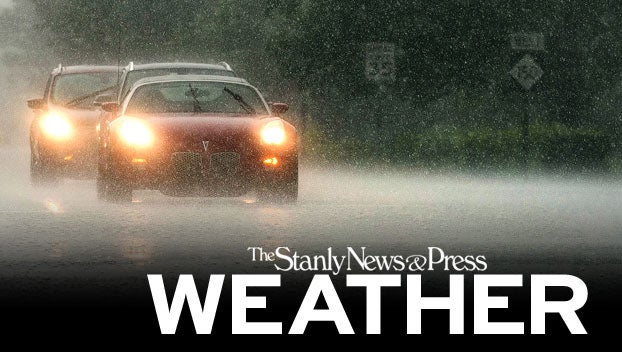ACCU WEATHER: Meteorological spring is here! Check out the updated spring forecast
Published 11:49 am Tuesday, March 1, 2022
|
Getting your Trinity Audio player ready...
|
By AccuWeather meteorologist and staff writer
Meteorological spring has sprung across the Northern Hemisphere, giving people weary of snow and cold a reason to rejoice, although the changing of the seasons does not necessarily mean the end to wintry weather.
March 1 is the first day of meteorological spring, a season that runs through the end of May each year. This is different from astronomical spring, which starts on the March equinox and ends on the June solstice, two astronomical events that occur at different times every year due to Earth’s elliptical orbit around the sun. This year, the equinox occurs at 11:33 a.m. EDT on Sunday, March 20, and the solstice takes place at 5:13 a.m. EDT on Tuesday, June 21.
The consistency of meteorological seasons makes it easier for forecasters to compare one season to those of years past than it is with astronomical seasons.
February featured a reprieve from the bitterly cold winter weather for most of the East Coast following a frozen January. There were still some waves of chilly air and periodic snow, but residents of New York City, Washington, D.C., and Pittsburgh did not have to shovel as much snow or spend as much on heating costs in February as opposed to January.
Instead, Arctic air focused on the central United States with blasts of subzero temperatures across the northern Plains and even periodic intrusions of cold air as far south as Texas. Snow and ice accompanied one of these Texas cold blasts in early February causing widespread power outages and significant travel delays statewide, although it was not nearly as extreme as the winter weather that hit the state in February 2021.
February even brought the return of rain and high-elevation snow to Southern California, although it was far from putting a dent in the state’s long-term drought.
AccuWeather’s team of long-range forecasters, led by Senior Meteorologist Paul Pastelok, has provided an update to the spring outlook after the initial forecast was released on Groundhog Day.
In crafting a long-range forecast, Pastelok and his team used weather analogs. Analogs are years in the past when the weather patterns around the globe were similar to what is currently happening. Studying the past gives forecasters clues to what may unfold in the future. These meteorological breadcrumbs have indicated that this spring could feature unusually late winter storms, both along the East Coast and West Coast, and even the development of an out-of-season tropical system.
Take a look at the complete region-by-region breakdown of AccuWeather’s U.S. spring forecast below:
Winter could linger over Northeast, Midwest
Winter took its time settling in across the Midwest and Northeast with Chicago setting a new record for its latest-ever first measurable snow of the season. However, as the calendar flipped from December to January, so too did the weather pattern. January ushered in waves of snow as far south as Mississippi and the coldest air in three years across the Ohio Valley, including subzero temperatures in Cleveland and Pittsburgh for the first time since January 2019.
The pattern broke in February, allowing the Northeast to thaw from the January freeze, but AccuWeather meteorologists warn that it’s still too early to pack away winter coats and snowblowers.
“There’s going to be some type of setback as we head into either late March or April,” Pastelok said, meaning that cold air will once again chill the regions, although not to the magnitude of the Arctic intrusions that unfolded in January.
The midspring cooldowns will bring the potential for frost and freezes about one or two weeks later than normal, potentially impacting when farmers and gardeners decide to plant for the season.
The extended spells of chilly air will not come alone.
“March does look chilly in the Northwest with more rain and snow compared to February and January,” Pastelok explained. He added that there could even be a snowstorm or two during April.
This has already been the snowiest winter in three years for the Washington, D.C., area with 12.3 inches accumulating in January alone. With more prospects of snow, the nation’s capital could finish with more snow than the 16.9 inches that accumulated in the winter of 2018-2019 and the 22.2 inches that fell during the winter of 2015-2016.
Snow has not fallen evenly across the Northeast throughout the winter. For instance, Philadelphia measured 12.1 inches in January, and just 50 miles away, Atlantic City, New Jersey, measured 33.2 inches in the same time frame, making it the snowiest January in Atlantic City history. This was followed up by an almost snowless February with 0.4 of an inch accumulating in Philadelphia and just a trace of snow in Atlantic City.
The potential for mid- to late-spring storms will also bring the risk of flooding, especially during the second half of the spring. The highest risk of flooding downpours is expected to be across the Ohio Valley, and the threat will be paired with the potential for some severe weather.
AccuWeather long-range forecasters have increased the rainfall forecast for the Tennessee Valley and lower Ohio Valley since the initial spring forecast was issued in early February, leading to an even higher threat of flooding.
There could also be a higher-than-normal risk of ice jams and flooding, particularly across the Midwest, in March. “The up-and-down temperature forecast of melting and refreezing may go on in these areas, leading to block-ups and flooding,” Pastelok said.
Pastelok added that there is concern for moderate flooding in the Red River Valley in the Upper Midwest this spring due to ice jams following an uptick in snowfall during late winter.
Tropics may spring to life before official start of hurricane season
As storm systems track across the Midwest and Northeast throughout the spring, some areas to the south will miss out on most of the precipitation, raising some short-term drought concerns.
Pockets of moderate drought have developed across the region and could expand in the coming months.
“We believe the drought will linger, more focused on southeast North Carolina, eastern South Carolina to northern Florida,” Pastelok said.
There is a wild card late in the spring that could erase the drought concerns in the Southeast: an early tropical system.
The Atlantic hurricane season does not officially start until June 1, but a storm could spin up before the season gets underway.
Pre-season tropical systems have not been out of the ordinary as of late, with a named storm developing in either April or May every year dating back to 2015. Some of these systems have impacted the U.S. mainland, including Tropical Storm Arthur, which brushed the Carolinas in May of 2020, and Tropical Storm Alberto, which made landfall along the Florida Panhandle in May of 2018.
The National Hurricane Center has started to look into moving the official start of the Atlantic hurricane season to earlier in the year following the recent trends, but as of early 2022 the dates have not been altered.
The regions where tropical development is most likely are “anywhere from the northeast Gulf, northern Florida Coast to Carolina Coast in May or early June,” Pastelok said. Any weather disturbances that move over these waters during the second half of spring could evolve into a named tropical system if the conditions are right.
A tropical storm that spins up close to the shores of the U.S., rather than far out over the Atlantic Ocean, is sometimes called a “home brew” system by meteorologists.
If a tropical system does manage to spin up in April or May, a landfall in the southeastern U.S. cannot be ruled out. A landfalling system could be potentially damaging, but heavy tropical downpours could also alleviate the pockets of drought across the Southeast.
Severe weather season to ignite early
Severe weather season will waste no time kicking into gear this year, although the worst of the storms and tornadoes may once again focus on areas outside of the traditional Tornado Alley.
“The early part of the severe weather season could get going quickly,” Pastelok warned.
Once the severe weather season kicks off, it is predicted to ramp up quickly and maintain that pace throughout most of the spring.
“April looks like a very active month,” Pastelok said, adding that it could be a busy month not just for severe weather but also for tornadoes.
AccuWeather is predicting that 2022 will feature a near to slightly above-normal number of tornadoes across the U.S. with April likely to be the busiest month in terms of tornadoes. More than 200 twisters are projected to touch down in April, most of which will spin up across the central U.S.
The April 2022 prediction is more than double the number of tornadoes that were reported last April, which stands at 73, and above the long-term average of 178 tornadoes in April.
Similar to 2021, the bulk of the severe weather is not expected to focus on the traditional Tornado Alley, which extends from central Texas through Nebraska.
Instead, the highest risk of damaging thunderstorms and tornadoes in March, April and May will focus on the Gulf Coast states, Tennessee Valley, mid-Mississippi Valley and into the Ohio Valley. This includes St. Louis, Kansas City, Indianapolis, Nashville, and Cincinnati.
Areas hit by the rare December derecho and the historic tornado outbreak of Dec. 10-11, 2021, will also face an elevated danger for damaging thunderstorms and tornadoes in March, April and May.
Some storms and tornadoes will still be possible in Tornado Alley, but the severe potential will be limited due to the prolonged drought in the High Plains.
As warm weather builds over the southern and central Plains early in the spring, areas farther north will have to wait for the wintry weather pattern to break.
“We’re feeling highly confident that there’s going to be a lot more cold air still around the northern Rockies and northern Plains,” Pastelok said. “We could even see a few late-season snow events as well.”
This is good news for ski resorts across the northern Rockies that hope to remain open later than normal this year, but people planning vacations to places such as Yellowstone National Park and Glacier National Park late in the spring could encounter bouts of wintry weather.
Drought to maintain grip on western US
The back-and-forth weather pattern along the West Coast this winter will persist into the spring, including the potential for late-season storms across California.
The winter started off strong for the drought-stricken West Coast with waves of storms unloading widespread rain and yards of mountain snow across Washington, Oregon and California. This pattern broke in January and February, raising concerns once again about whether the drought would worsen before conditions improve.
CLICK HERE FOR THE FREE ACCUWEATHER APP
The stormy pattern is projected to resume in March, according to Pastelok, delivering much-needed precipitation to the region. “It does not look very wet, but there still can be some storms in March and April,” Pastelok said.
This will not be a drought-ending scenario that many are hoping for, especially if the storms take a more northerly track. This would direct the storms into the Pacific Northwest and away from Southern California and the interior Southwest.
“There’s still an opportunity for a little bit of extra rain through April to contribute more to water reservoirs for the late spring and summer,” Pastelok said. He added that the precipitation deficits that built up during midwinter could impact the summer and fall wildfire season even with the prospects of late-winter storms.
As of Feb. 24, 2022, 23% of the western U.S. was experiencing extreme drought and 4% of the region was under exceptional drought, according to the U.S. Drought Monitor. This is a reduction from one year prior when more than 42% of the region was experiencing an extreme drought and 23% was under exceptional drought.
Despite this improvement, most of the region is still experiencing long-term drought hardships.
The worst of the drought conditions through the spring is projected to focus on the Great Basin, Four Corners and into the High Plains. This means that conditions could get worse before they get better, including the water tables that feed into Lake Mead, which in 2021 hit its lowest level since the construction of the Hoover Dam.
Some moisture could make it into the interior Southwest if a few storms take a more southerly track in March and even as late as April, but it will not be enough to alleviate the long-term drought, Pastelok said.
As a result, much of the region will experience a warmer-than-normal spring, including Phoenix, Las Vegas and Albuquerque, New Mexico.
Last year, Phoenix kicked off April with 13 consecutive 90-degree days. While such a feat is hard to duplicate in back-to-back years, the anticipated warmth cannot rule out another extended streak of 90-degree days in the Valley of the Sun.
The early arrival of spring warmth across the interior Southwest will be followed up by a summer preview in May before the official start of meteorological summer on June 1.






